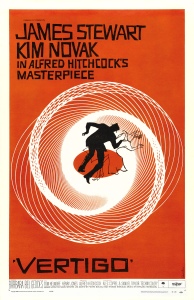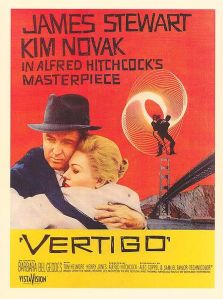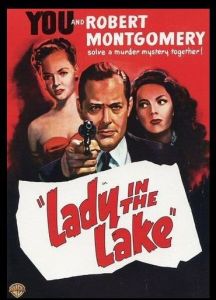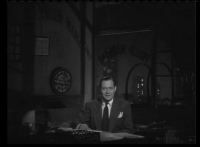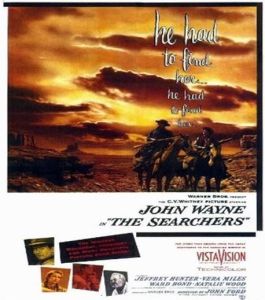Year: 1958
Director: Alfred Hitchcock
Stars: James Stewart, Kim Novak, Barbara Bel Geddes
As I continue analyzing the film Vertigo, this week’s blog concentrates on the three main actors in the film. James Stewart plays John “Scottie” Ferguson, Kim Novak plays the dual roles of Madeleine Elster/Judy Barton, and Barbara Bel Geddes plays Midge Wood. I consider each of these actors to be a different type of actor with their own style and unique characteristics.
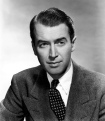 The protagonist of Vertigo, James Stewart as John Ferguson, was a true star in Hollywood. A star is defined as “a distinctive screen persona who is well known and popular with the movie going public” (Goodykoontz, Jacobs, 2014, chap. 9, p. 119) and Stewart in considered one of the most recognizable and popular actors in film history. The combination of a distinctive drawl, slow way of talking, and nervous tics were characteristics that he used to develop a stylized method of acting (Eliot, 2006). Stewart appeared in a wide variety of movies genres, from westerns to dramas, and his unique persona was able to shine through and add a distinctive touch to each role. Stewart’s performance in Vertigo, however, was more reserved and realistic. For instance, Stewart’s drawl and slow way of talking were evident in the scene where he and Barbara Bel Geddes discuss their broken engagement but he used them to portray a forced nonchalance and cavalier attitude that masked his true feelings. The scenes where he was more expressive are appropriate to the action, such as in the scene where he was barely hanging on to a
The protagonist of Vertigo, James Stewart as John Ferguson, was a true star in Hollywood. A star is defined as “a distinctive screen persona who is well known and popular with the movie going public” (Goodykoontz, Jacobs, 2014, chap. 9, p. 119) and Stewart in considered one of the most recognizable and popular actors in film history. The combination of a distinctive drawl, slow way of talking, and nervous tics were characteristics that he used to develop a stylized method of acting (Eliot, 2006). Stewart appeared in a wide variety of movies genres, from westerns to dramas, and his unique persona was able to shine through and add a distinctive touch to each role. Stewart’s performance in Vertigo, however, was more reserved and realistic. For instance, Stewart’s drawl and slow way of talking were evident in the scene where he and Barbara Bel Geddes discuss their broken engagement but he used them to portray a forced nonchalance and cavalier attitude that masked his true feelings. The scenes where he was more expressive are appropriate to the action, such as in the scene where he was barely hanging on to a 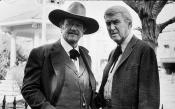 gutter high above the streets of San Francisco. James Stewart was considered a star even into his later years when he accepted supporting roles and his star power was still evident when he shone in the role of Doc Hostetler in 1976’s The Shootist, starring John Wayne (pictured right).
gutter high above the streets of San Francisco. James Stewart was considered a star even into his later years when he accepted supporting roles and his star power was still evident when he shone in the role of Doc Hostetler in 1976’s The Shootist, starring John Wayne (pictured right).

I consider Kim Novak, who starred opposite James Stewart in Vertigo, a personality actor. As “an actor whose own personality tends to define all the characters he or she portrays” (Goodykoontz, Jacobs, 2014, chap. 9, glossary), Novak made a career out of playing the sexy, blond seductress. In real life, Novak was indeed a beautiful blond with a soft voice and natural sexuality, and these qualities showed through on film in almost every character she played. In Vertigo, she played the dual roles of Madeleine/Judy who intentionally seduced and used Stewart’s character as an alibi to cover her involvement in murder. In this picture, she intentionally ignores Ferguson as she glides by him, using her beauty  and allure to attract his interest. Her acting style in this movie is realistic and similar to Stewart’s, which could be attributed the Alfred Hitchcock’s direction. As a personality actor, Novak never enjoyed the level of fame that Stewart achieved as a star. She did, however, bring her beauty and sexuality to all of her films and had a definite impact on the movies she made.
and allure to attract his interest. Her acting style in this movie is realistic and similar to Stewart’s, which could be attributed the Alfred Hitchcock’s direction. As a personality actor, Novak never enjoyed the level of fame that Stewart achieved as a star. She did, however, bring her beauty and sexuality to all of her films and had a definite impact on the movies she made.
 I find Barbara Bel Geddes the most interesting of these three actors. This character actor is probably best known as the strong matriarch Miss Ellie Ewing on the TV show Dallas, but Bel Geddes also enjoyed a stage and film career. She was never cast as a leading lady, but instead played a wide variety of supporting roles that helped her avoid being typecast (Goodykoontz, Jacobs, 2014). As Midge Wood in Vertigo, Bel Geddes played the frustrated ex-fiancée of
I find Barbara Bel Geddes the most interesting of these three actors. This character actor is probably best known as the strong matriarch Miss Ellie Ewing on the TV show Dallas, but Bel Geddes also enjoyed a stage and film career. She was never cast as a leading lady, but instead played a wide variety of supporting roles that helped her avoid being typecast (Goodykoontz, Jacobs, 2014). As Midge Wood in Vertigo, Bel Geddes played the frustrated ex-fiancée of 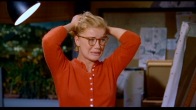 Stewart’s character. As the third side of a love triangle, Midge tore at her hair when she realized an attempted seduction of Ferguson fell flat (pictured right). Her acting appeared the most realistic of the three in this movie and her ability to play the role of girlfriend/friend so well added an important dimension to this film.
Stewart’s character. As the third side of a love triangle, Midge tore at her hair when she realized an attempted seduction of Ferguson fell flat (pictured right). Her acting appeared the most realistic of the three in this movie and her ability to play the role of girlfriend/friend so well added an important dimension to this film.
References
Eliot, M. (2006). Jimmy Stewart: A Biography. Crown Archetype.
Goodykoontz, B., & Jacobs, C. P. (2014). Film: From watching to seeing (2nd ed.). San Diego, CA: Bridgepoint
https://www.google.com/search?q=barbara+bel+geddes
https://www.google.com/search?q=james+stewart
https://www.google.com/search?q=kim+novak
https://www.google.com/search?tbm=isch&q=Vertigo&gws_rd=ssl#imgrc=_
